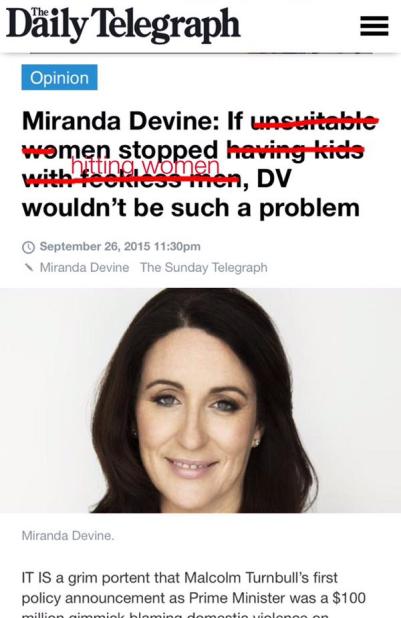 Apparently someone called Miranda Devine wrote a rather repugnant article. You can see the original text under the scribblings on the left-hand side of this post. This article was pretty awful in and of itself, but so is the redone title and so was the response to the mildest protest about the new title.
Apparently someone called Miranda Devine wrote a rather repugnant article. You can see the original text under the scribblings on the left-hand side of this post. This article was pretty awful in and of itself, but so is the redone title and so was the response to the mildest protest about the new title.
The original title reads:
“If unsuitable women stopped having kids with feckless men, Domestic Violence wouldn’t be such a problem.”
The ‘corrected’ version reads:
“If men stopped hitting women, domestic violence wouldn’t be such a problem.”
The first is pretty disgusting, but does at least limit it to certain kinds of women involved with certain kinds of men, rather than encompassing whole genders.
The second is, arguably, worse since it’s painting men as a whole as the problem, and characterising Domestiv Violence (Intimate Partner Violence as its more often known now) as exclusively a women’s issue, perpetrated by men.
That is far from the case. Various studies and sources place IPV rates against men anywhere as high as total parity (the same rate of occurrence against men as against women). At the same time, provision of social, legal and political support for men runs at barely 1% – if that – of the support for women. There are virtually no shelters and no provisions such as those that exist for women to aid in getting away from an abuser, getting housing benefit and so on.
The NHS’ sources think that IPV against men runs at about 25%.
You can find some more resource linked at Mankind Initiative.
Wikipedia (always check the sources) links a variety of data sources.
The CDC in the US reckons over 1/4 of men are victims of IPV in their lifetime (as opposed to 1/3 of women).
The Australian Bureau of Statistics estimates about 1/3 men are victims of domestic abuse.
Parity reckons about 40% of IPV victims are male.
Ireland reckons half as many men as women suffer IPV, which is still a significant amount.
The long and the short of it is that domestic abuse against men, under a variety of methods, estimates that men are victims of domestic abuse from around 15% of the total to over 50% of the total with most clustering in the 25%-33% bracket in credible studies going back as far as 1975.
In 2011 (the most complete and up to date statistics I could find) it was recorded that there were over 4,000 shelter places for women and a grand total of 16 for men. The second of these numbers has almost certainly gone down as men’s charities – already struggling for money – have been defunded by the government as part of austerity.
So, to recap, there’s a lot of domestic violence towards men, perhaps even as much as women suffer, but it’s not taken seriously and there’s little to no help for men who suffer it.
So what happened when this data was presented? A sudden wave of skepticism, which I would normally welcome, but from people who will swallow statistics such as the 1/4 rape statistic without a hint of the same skepticism that arises when presented with men’s suffering. It’s hard not to get angry and it’s hard not to be bitter at such hypocrisy.
Their main objection appeared to be an article referring to the Australian data above, stating that the definition was unclear (true, this is often a problem with these kinds of surveys on intimate violence and rape) and that it had a wide margin of error (as much as 50%). What they failed to realise as that a margin of error cuts both ways, it might be over-reporting by 50% or under-reporting by the same amount. Placing the total percentage of Australian men suffering IPV between 16% and 50% – which would still be consistent with other studies in other countries and would still not be an insignificant number at all. Australian provision for men suffering IPV is – again – abysmally low, but there’s a good list of services for Australia here.
Statistics on these topics are notoriously unreliable, for male and female IPV, but the same problems of wording, activist pseudo-science and people’s reluctance to admit they’re being abused afflict studies in the same way. Whatever the true numbers are – and some genuine academic studies need to be conducted without bias – it is clear that men are suffering significantly. Perhaps as much as women. Men are also facing a big barrier, in addition to shame, emasculation and societal pressure. The services that do exist, the lobbies that are established treat IPV as a women’s issue, a feminist issue and are often caught up entirely in that ideology. Men who need help are likely to be suspected of being the perpetrators, due to this bias, and those who advocate for them are likely to be accused of undermining support for women, hiding (or even engaging in apologetics for) the abuse women get, and worse.
There is no reason men and women alike can’t get support through increased provision for both. It doesn’t have to take away from support for women and even if it did, the total number of people helped would remain the same. perhaps even be higher due to the economy of scale.
Men need advocacy, and feminist activists need to stop treating the abuse of men as a joke, or a threat to women.
Everyone deserves support.